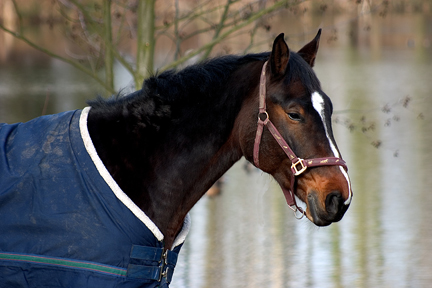
Vitamin D is fat soluble. Fat soluble vitamins are stored within the body’s fat and liver and can become toxic if certain levels are reached. Thirty to 90 minutes in the sun will give the average person all the required daily vitamin D. But a horse’s hair coat alone creates such a significant barrier to absorption that it typically takes 5 to 8 hours of exposure to ultra violet light for horses to produce enough vitamin D. Compound that with added blocks like fly spray, coat conditioner, blanket or sheet, or decreased body oils due to bathing, and it becomes apparent that in some cases, horses may not get enough of this vital ingredient.
How does sunshine convert to vitamin D? The key is in the skin’s oils, which contain a derivative of cholesterol called 7-dehydrocholesterol. When exposed to sunshine, this compound is converted to Cholecalciferol, which is then converted to the actual vitamin D, known as 25-hydroxy-cholecalciferol, or D3 for short.
Why Vitamin D Is Important For Horses:
Vitamin D is vital for proper absorption of calcium and phosphorus. This two minerals are important for strong bones.
· It maintains the levels of calcium in the blood.
· It is required for the absorption of both calcium and phosphorous which are key minerals for bone health.
· It has a role in cell growth and development.
Signs of Vitamin D Deficiency In The Horse:
· Deficiency is known to cause rickets in others animals and contribute to weak bones. Rickets is rarely observed in horses.
· Research suggests that deficiency may play a role in insulin resistance.
· Research is now being conducted to determine if deficiency may contribute to gastric ulcers.
Signs of Vitamin D Toxicity In Horses:
Signs of vitamin D toxicity are not visible but can be deadly. Excess levels cause calcium to deposit in the soft tissues and joints. Too much vitamin D is a known contributor to calcification of the blood vessels, heart, kidney and other organs. It is may also contribute to osselets, bone spavins and ringbone. It is important to note toxicity has not been found in horses that are out in the sun all day. The body only processes what is needed.
Vitamin D Sources for Horses:
Vitamin D is known as the sunshine vitamin. A few hours of daily exposure to sunshine usually maintains healthy levels. It is also found in sun cured hay, though levels start to deplete after 6 months of storage. Small quantities are also found in most fortified feeds.
Vitamin D Supplements for Horses:
Vitamin D and its’ role and its’ effects in the equine body is probably the second most researched vitamin after vitamin E. It is the most common overdosed vitamin due to over supplementation. Because so many horses are now kept in stalls or are covered with blankets or sheets while outside, vitamin D deficiency has become a concern. Most experts agree that horses turned out in pastures and paddocks each day without blankets or sheets do not need supplementation. Opinions vary about added supplements for horses that are stalled and do not receive several hours sun exposure each day. Because vitamin D toxicity can have dire consequences, vets and nutritionists advise checking levels through a blood test before increasing the dosage.
Recommended NCR Daily Requirements of Vitamin D For Horses (2007):
· Requirements for all adult horses including mares pregnant or lactating, stallions and horses under a heavy work load
o 1,000 pound (460 kg) adult horse – 3036 I. U.
o 1,100 pound (500 kg) adult horse – 3300 I. U.
Kirk W Carter, MBA – Cargill Equine Specialist
Ref: HorseChannel.com / Dr. Juliet Getty, Getty Equine Nutrition LLC